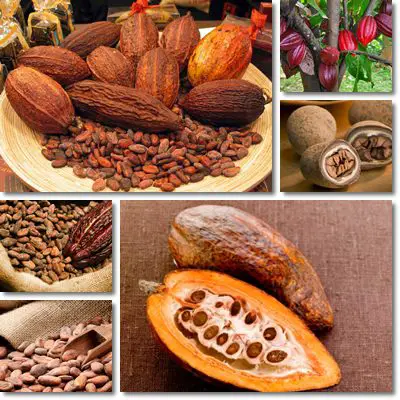Chocolate is the ultimate comfort food and a luxury accessible to many. The secret to this mouth-watering delight is the simple cocoa or cacao beans, the seeds of the Theobroma cacao, or the cacao tree. The higher the cocoa percentage in chocolate, the healthier it is. This is because cocoa is an incredible source of powerful antioxidants that boast astounding benefits on the cardiovascular and nervous systems in particular.
It can also be used externally on the skin and has a rejuvenating and repairing effect, improving its aspect.
Numerous studies reveal that people who eat cocoa or dark chocolate (the variety with the highest percentage of cocoa) on a regular basis not only live longer and look much younger than their real biological age, but are also happier and healthier in the sense that they are less likely to develop chronic diseases such as cancer, obesity, depression or degenerative neurological or neuro-muscular disorders. It is believed the antioxidant compounds found in cocoa are responsible for such long-term health benefits on both physical and mental health.

Where does chocolate come from and what do cocoa trees and beans look like?
The cocoa tree produces beautiful, elongated, brightly-colored pods with deep creases, ranging in color from green and lemon-yellow to bright orange and red-violet. Each color is indicative of a different ripening stage. When cacao pods turn bright orange, they are the ripest. Even so, they are a genuine delight to the eyes. But instead of growing on the branches, cocoa pods grow on the trunk of the tree, which makes for a somewhat peculiar image for anyone who sees them for the first time.
Each cocoa pod may contain somewhere between 20-50 seeds, covered by a sticky flesh. Cocoa seeds are not chocolate-brown, but white, mushy, buttery beans which turn a deep, beautiful red-brown when left to dry.
Few varieties of cocoa beans actually remain white even after drying and processing for use in chocolate making.
Update 2020:
Recently, a new cocoa bean variety has been discovered, from which a novelty type of chocolate is being made. The pink cocoa bean, also called the ruby cocoa bean, is the source of a rare, pink chocolate that surprises consumers with a mix of cocoa and delicate berry flavors.
Regular cocoa consumption is highly beneficial for good health. Cocoa powder and its most famous byproduct, chocolate, are surprisingly good for heart and brain and nervous system health in particular. Most of the health benefits of cocoa butter and cocoa solids derive from the incredible antioxidant content of the beans. See below what are the top 5 reasons why cocoa and (preferably dark) chocolate are good for you.

What are the benefits of Cocoa Beans?
Natural antidepressant properties
Eating cocoa or dark chocolate regularly has been suggested to have the same effect as taking antidepressant medication. Cocoa stimulates the production of dopamine and serotonin, two neurotransmitters which help regulate mood. Both dopamine and serotonin generate positive feelings such as happiness, calm, joy, a feeling of wellbeing, relief, optimism and increase sleep quality.
Regulates appetite
Serotonin is a neurotransmitter synthesized by tryptophan, an essential amino acid. Eating starchy or sweet foods (carbohydrates basically) such as cocoa produces tryptophan which is then converted into serotonin. Serotonin basically contributes to emotional stability and allows for appetite regulation. A pronounced deficiency of the amino acid may explain feelings of anxiety and depression in otherwise healthy individuals.
Memory enhancer
Cocoa is a natural brain stimulant which increases the production of serotonin, a neurotransmitter responsible for memory support, among other benefits. Children and adolescents are sometimes advised to nib on a few cubes of dark chocolate prior to an exam in order to enhance their memory and performance. But eating too much cocoa or dark chocolate may prove counterproductive if you want to have a good night’s rest because the caffeine in them may overexcite the brain and lead to alertness and insomnia.
See the top 7 side effects of eating chocolate.
Blood pressure regulator
Cocoa helps dilate blood vessels which prevents plaque detached from artery walls from blocking normal blood flow and causing serious cardiovascular events such as a stroke or heart attack. Antioxidant compounds also found in cocoa beans help lower LDL (bad low-density lipoprotein) cholesterol levels and prevent the oxidation of these lipids, thin the blood and preserve blood vessel integrity, thus reducing stroke and heart attack risks.
Powerful anti-aging properties
Cocoa is an incredible source of natural antioxidant polyphenols, containing over 700 known anthocyanins, flavonols, flavanols and flavanones.
These powerful natural compounds protect our blood vessels, heart, brain, and other organs from damage caused by free radicals at cell level. Free radicals are actually reactive oxygen molecules found everywhere from the air we breathe to the water we drink.
By causing damage to the very building block of our body, cells, they corrupt entire tissues and organs. Cell damage means the installation of chronic disease (diabetes, cancer, bowel diseases, neurological degeneration and so on). Antioxidant rich-foods such as cocoa beans promote cell regeneration leading to healthy tissues and organs. This not only prevents chronic disease, but also ensures a fresh, radiant, youthful appearance.
What are the side effects of Cocoa Beans?
People don’t just eat cocoa beans, but they eat cocoa butter and cocoa which are extracted from the beans and commonly used in chocolate, chocolate and other byproducts. People eating either cocoa butter or cocoa may experience any of the following side effects:
Digestive upset
Too much cocoa butter and/or cocoa can cause stomach upset with symptoms such as nausea, vomiting, loose stools and diarrhea, acid reflux and heartburn, but also gastritis flareups.
Cardiovascular side effects
Cardiovascular side effects such as arrhythmia or abnormal heart rhythm, increased heart rate and palpitations can occur if you have too much cocoa or cocoa byproducts such as dark chocolate. Side effects are dose-dependent.
Other side effects
Too much cocoa can lead to insomnia and disturbed sleep, but also agitation, restlessness or even increased anxiety, headaches or irritability, dizziness or lightheadedness. The culprits are components occurring naturally in cocoa known as theophylline, theobromine and caffeine.
Allergic reactions
It is possible to be allergic to cocoa or even cocoa butter. Symptoms of an allergic reaction may include a skin rash, swelling of the face or airways, closing of the airways, difficulty breathing, wheezing, coughing, hoarseness, low blood pressure, fainting and ultimately anaphylactic shock. Find out more about chocolate allergy.
Conclusion
Consumption of cocoa and high-quality chocolate products has been correlated with better health in general and is a dietary habit of many people pushing towards 100. Among the health effects observed in cocoa and chocolate consumers, a lower incidence of mental disorders and cardiovascular disease has been observed as well as delayed cognitive decline. Many of the world’s centenarians admit to indulging in chocolate as a favorite treat, although in reasonable amounts. Cocoa and dark chocolate are presumed to be one of the secrets to a long, happy life.
